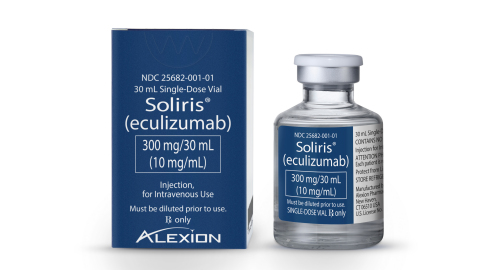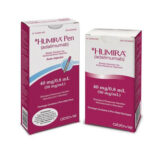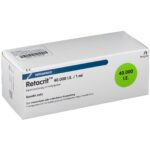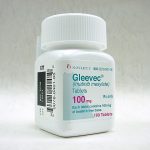Soliris: How it Works, Side Effects, Cost

Soliris is a brand of eculizumab discovered, developed, and commercialized by Alexion. Soliris works by selectively inhibiting activation of specific proteins in the complement system (C5a and C5b), which play a role in the pathophysiology of multiple rare diseases.
Soliris is used for the treatment of patients with paroxysmal nocturnal hemoglobinuria (PNH) to reduce hemolysis, the treatment of patients with atypical hemolytic uremic syndrome (aHUS) to inhibit complement-mediated thrombotic microangiopathy, the treatment of adult patients with generalized Myasthenia Gravis (gMG) who are anti-acetylcholine receptor (AchR) antibody positive, and neuromyelitis optica spectrum disorder (NMOSD) in adult patients who are anti-aquaporin-4 (AQP4) antibody positive. Soliris is not indicated for the treatment of patients with Shiga-toxin E. coli-related hemolytic uremic syndrome (STEC-HUS). It is not known if Soliris is safe and effective in children with PNH, or gMG, or NMOSD.
How is Soliris used?
The medicine can only be obtained with a prescription and must be given under the supervision of a doctor who has experience in the management of patients with kidney disorders and disorders affecting the nervous system or the blood.
Soliris is given as an infusion (drip) into a vein and the recommended dose depends on what it is used for, and for patients under 18 years of age, on their bodyweight. Soliris is given weekly initially and then every two or three weeks.
Patients are monitored for any reactions during the infusion and for at least one hour afterwards. In case of any infusion-related reactions, the doctor may slow down or stop the infusion.
In some patients who receive plasma exchange (the removal, treatment and return of their own blood plasma) or infusion of plasma, additional doses of Soliris are required.
Soliris should be given for life unless the patient develops serious side effects.
How does Soliris work?
The active substance in Soliris, eculizumab, is a monoclonal antibody (a type of protein) that has been designed to attach to the C5 complement protein, which is a part of the body’s defence system called the ‘complement system’.
In patients with PNH, aHUS, myasthenia gravis and NMOSD, the complement proteins are over-active and damage the patients’ own cells. By blocking the C5 complement protein, eculizumab prevents complement proteins from damaging cells, thereby helping to relieve the symptoms of these diseases.
What benefits of Soliris have been shown in studies?
For PNH, Soliris was compared with placebo (a dummy treatment) in one main study involving 87 adults with PNH who had had at least four blood transfusions for anaemia in the previous year. The main measures of effectiveness were the effect of Soliris on blood levels of haemoglobin and the need for transfusions. Haemoglobin is the protein in red blood cells that carries oxygen around the body. In patients with PNH, the breakdown of red blood cells leads to a reduction in haemoglobin levels. Treatment with Soliris over 26 weeks led to stable haemoglobin levels in 49% of the patients (21 out of 43), without the need for transfusions of red blood cells. In comparison, none of the 44 patients receiving placebo had stable haemoglobin levels, and they needed an average of 10 transfusions.
In a study in 7 children with PNH who had had at least one transfusion in the previous two years, all patients received Soliris. Six out of seven patients did not need any transfusion of red blood cells, and haemoglobin levels improved during 12 weeks of treatment with Soliris.
A registry study of patients with PNH who had never had a blood transfusion looked at the blood levels of the enzyme lactate dehydrogenase (LDH). Levels of LDH rise as breakdown of red blood cells increases. The study found that treatment with Soliris for 6 months led to clinically meaningful reductions in levels of LDH, indicating reduced breakdown of red blood cells.
For aHUS
For aHUS, Soliris was studied in three main studies involving 67 patients. The first study involved 17 patients with aHUS who did not respond to or could not be treated with plasma exchange or infusion. Treatment with Soliris increased platelet counts in 82% of the patients, and platelet counts rose to normal levels in 87% (13 out of 15 patients) who had low platelet counts at the start. In addition, 76% achieved haematological normalisation (levels of platelets and LDH within normal levels).
The second study, involving 20 patients with aHUS who were already receiving plasma exchange or infusion, resulted in 80% of the patients no longer requiring plasma exchange, infusion or dialysis and 90% of the patients achieving haematological normalisation after treatment with Soliris.
The third study involved 30 patients with aHUS who had received at least one dose of Soliris. Treatment increased platelet counts to normal levels in 83% of the patients, while the platelet count rose to normal levels in 77% (10 out of 13 patients) who initially had low platelet counts.
For Myasthenia gravis
For myasthenia gravis, Soliris was compared with placebo in one main study involving 126 adults with myasthenia gravis who had previously received standard treatment which had failed. Treatment with Soliris improved patients’ symptoms and their ability to undertake daily activities based on a standard scoring system. Soliris led to a reduction of 4.7 points on the scale whereas placebo led to 2.8 point reduction after 26 weeks. A reduction in the score by 2 points indicates a clinically significant improvement of the patient’s condition.
For NMOSD
For NMOSD, Soliris was compared with placebo in one main study involving 143 adults with NMOSD whose disease was relapsing. The main measure of effectiveness was the time it took until a certain number of patients experienced a relapse. After around 22 months on average, 3% of patients treated with Soliris had had a relapse, whereas 43% of patients treated with placebo had already had a relapse after around 9 months on average.
What are the risks associated with Soliris?
The most common side effect with Soliris (which may affect more than 1 in 10 people) is headache. The most serious side effect, which may affect up to 1 in 100 people, is meningococcal sepsis (when bacteria and their toxins circulate in the blood and damage the organs).
Because of the increased risk of developing meningococcal sepsis, Soliris must not be given to people who have an infection caused by Neisseria meningitides; it must also not be given to patients who have not been vaccinated against this bacterium, unless they have the vaccination and take appropriate antibiotics to reduce the risk of infection for two weeks after vaccination. For the full list of side effects and restrictions with Soliris, see the package leaflet.
You are encouraged to report negative side effects of prescription drugs to the FDA. Visit www.FDA.gov/medwatch or call 1-800-FDA-1088. Please see the Medication Guide and full Prescribing Information including Box Warning.
How much does Soliris cost?
| Quantity | Per unit | Price |
| 30 milliliters Soliris intravenous solution | $227.32 | $6,819.51 |





